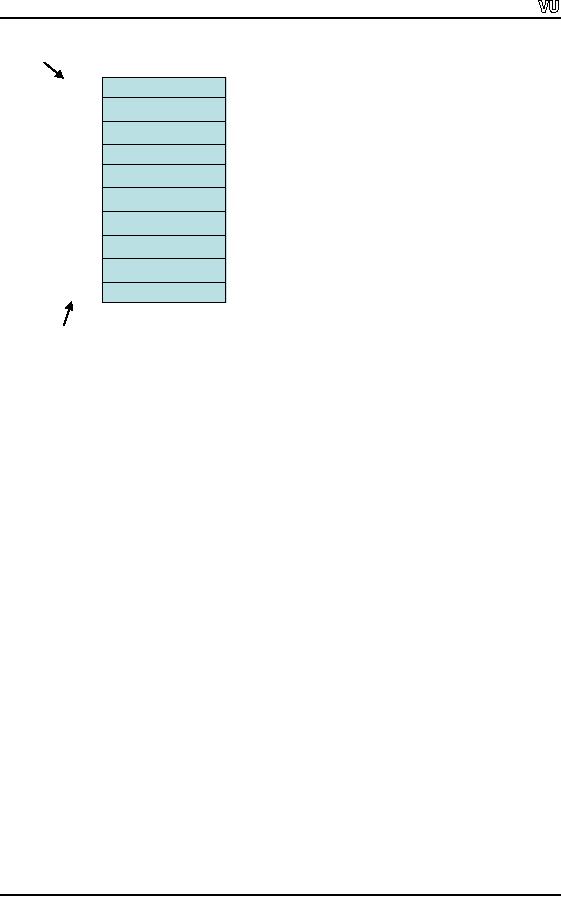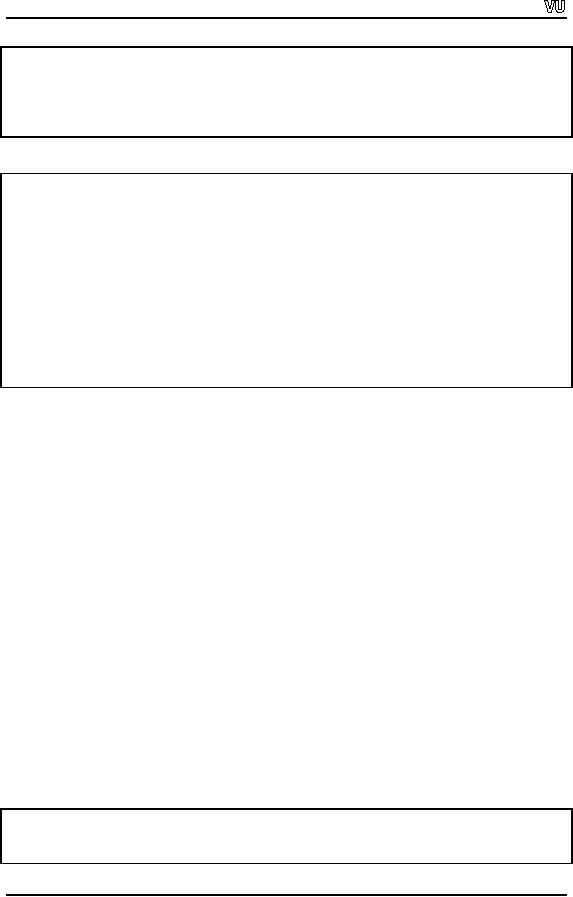 |

CS201
Introduction to Programming
Lecture
Handout
Introduction
to Programming
Lecture
No. 11
Reading
Material
Deitel
& Deitel - C++ How to
Program
chapter
4
4.2,
4.3, 4.4
Summary
·
Introduction
·
Arrays
·
Initialization
of Arrays
·
Sample
Program 1
·
Copying
Arrays
·
Linear
Search
·
The
Keyword `const'
·
Tips
Page
103

CS201
Introduction to Programming
Introduction
We have
started writing functions, which
will become a part of our
every program. As C
language
is a function-oriented language, so we will be dealing
with too many functions.
Our
programming toolkit is almost complete
but still a very important
component is
missing.
We are going to discuss this
component i.e. Arrays
in
this lecture.
Let us
consider an example about calculation of
average age of 10 students. At
first, we
will
declare 10 variables to store
the age of each student
and then sum up all the
ages and
divide
this with 10 to get the
average age. Suppose, we
have 100 students instead of
10,
we have
to declare 100 variables i.e.
one for each student's
age. Is there any other
way to
deal
with this problem? Arrays
are possible solution to the
problem.
Array is
a special data-type. If we have a
collection of data of same type as in
the case of
storage
of ages of 100 students,
arrays can be used. Arrays
are data structure in
which
identical
data types are stored.
The concept of arrays is
being explained further in the
following
parts of the lecture.
Arrays
In C
language, every array has a
data type i.e. name and size.
Data type can be any
valid
data
type. The rules of variable naming
convention apply to array names. The size
of the
array
tells how many elements are
there in the array. The size
of the array should be
a
precise
number. The arrays occupy
the memory depending upon
their size and have
contiguous
area of memory. We can
access the arrays using
the array index.
Declaration:
The
declaration of arrays is as
follows:
data_type
array_name
[size] ;
for
example:
int
ages[10];
Let's
consider an array int C[10];
This is an array of integer
and has a name 'C'. It
has a
size ten
which depicts that the
array `C' can contain ten
elements of int data type. In
the
memory,
the array occupies the
contiguous area, in this
case it will occupy forty
bytes
(one
int = 4 bytes). The elements
of the array are manipulated
using the index. In C
language,
the index of array starts
from zero and is one
less than array's size.
Index of
array is
also called subscript.
Memory
image of an array:
Name
Page
104

CS201
Introduction to Programming
Memory
24
C[0]
59
C[1]
C[2]
35
...
C[3]
...
..
..
..
C[7]
..
C[8]
...
C[9]
Index
In the
above figure, the memory
chunk containing the array C is shown. On
the first line,
C[0] is
written while on the 2nd line, C[1] is written
and so on. The number in
the [ ] is
the
index of the array. C[0] is
used for the first
element, followed by C[1]
for the second
element
and so on. It is important to
note that in an array the
index 6 ([6]) means
the
seventh
element of the array and
thus the eighth element
will have an index 7. Thus,
the
index of
the last element of the
array will be 1 less than
the size of the array. On
the right
hand
side, the values of the
elements are shown in the
memory i.e. the value of
the
element
at zero position ( C[0] ) is 24
while that of the element at
first position ( C[1] )
is
59 and so
on. The important thing to
be noted here is that the
indexing of the array
starts
from
zero, not from one. So in
the above example, the index
of the array C will be
from
C[0] to
C[9]. If we have an array of size
25, its index will be
from 0 to 24.
Usage of
Arrays
To
declare arrays, we have to
give their data type, name
and size. These are
fixed-size
arrays.
In the coming lectures, we
will discuss arrays without
using size at declaration
time.
Arrays may be declared with
simple variables in a single
line.
int i,
age [10];
int
height [10], length [10] ;
To access
array, we can't use the
whole array at a time. We
access arrays element
by
element.
An index (subscript) may be used to
access the first element of
the array. In this
case, to
access first element we
write like age[0]. To access
the 5th element, we will
write
age[4]
and so on. Using the
index mechanism, we can use
the array elements as
simple
variables.
Their use can be anywhere
where there we can use a
simple variable i.e. in
Page
105

CS201
Introduction to Programming
assignment
statements, expressions etc.
Please do not confuse the
usage of array and
declaration
of array. When we write int
age [10], it means we are
declaring an array of
type int,
its name is age and
its size is 10. When we write
age[5], it means we
are
referring to
the single element of the
array not the whole
array.
Consider
the example of student's ages
again. Is there a way to
calculate the average
age
of all
the students in an
array?
As we
know that arrays can be
accessed with indexing. So we
can use a 'for
loop'
as
under;
for (i =
0 ; i < 10 ; i++ )
{
cout
<< "Please enter the
age of the student ";
cin
>> age [i];
}
In the
above 'for
loop' the
value of i
is
changing from 0 to 9. Here the
loop condition is
i<10.
This
means that the cin
and
cout
statements
will be executed 10 times. We
have
used
i
as
the index of the array.
The index we are referring to
the array needs to be
an
integer.
It can be 4, 5 or an integer variable
like i. In the
first repetition, the value of
i
is
0,
i.e. age[0]
so
the value of first element
of the age will be
read.
In
the second repetition,
the
value of i
becomes 1
i.e. age[1]
so
the value of 2nd element of the age
will be read and
so on. We
get all the 10 values
from the user which
will be stored in the array
age.
Now we
will calculate the total of
ages. We can use another
'for
loop' to add
up all the
elements
of the array age.
int
totalAge = 0;
for (i =
0 ; i < 10 ; i++ )
{
totalAge
+= age [i];
}
In the
above loop, all the elements
of the array age will be
added to the variable totalAge.
When the
value of i
is 0
i.e. age[0]
the
value of first element will
be added to the
totalAge. As the
value of i
is
changing from 0 to 9 so all
the 10 elements of the array
will
be added
to the totalAge. By
dividing this totalAge
by 10
we will get the average
age.
Initialization
of Arrays
There
are many ways to initialize an
array. Don't use the default
initialization of arrays.
Compiler
may assign some value to
each declared array. Always
initialize the array
in
such a
manner that the process is
clear.
We can
initialize an array using a 'loop'
while assigning some
value.
Page
106

CS201
Introduction to Programming
int i,
age [10];
for ( i =
0; i < 10 ; i++ )
{
age[i] =
0;
}
With
the help of this simple
loop, we have initialized
all the elements of array
age
to
zero. In
the loop condition, we have
used the condition i <
10, where the
size of the array
is ten.
As we know, the array index
is one less than the size of
the array. Here we
are
using
i
as
the index of array and
its values are from 0 to
9.
We can
also initialize the array at
the time of declaration
as:
int
age [10] = { 0, 0, 0, 0, 0, 0, 0, 0, 0, 0
};
The
above statement creates an
array age
of
integers and initializes all
the elements with
zero. We
can use any value to
initialize the array by
using any other number
instead of
zero.
However, generally, zero is used to
initialize the integer
variables.
We can do
it by using the following
shortcut.
int
age [10] = { 0 };
The
above statement has also
initialized all the elements
of the array to zero.
We have
different ways of initializing
the arrays. Initialization
through the use of loop
is
a better
choice. If the size of the
array gets larger, it is
tedious to initialize at
the
declaration
time.
Consider
the following
statement:
int
age [ ] = { 0, 0, 0, 0, 0, 0, 0, 0, 0, 0 };
Here we
have not mentioned the size of
the array. The compiler is
quite intelligent as it
detects
the initialization list
which consists of ten 0's.
Therefore, it creates an array of
10
integers
and initializes all the
elements with zero.
The
index of the arrays starts
from the index 0 and is up
to one less than the size of
the
array. So
if the size of the array is
ten, the index will be
from 0 to 9. Similarly, if the
size
of the
array is 253, the index
will be from 0 to
252.
Sample
Program 1
Problem
Statement:
Page
107

CS201
Introduction to Programming
Write a
program which reads positive
integers from the user
and stores these ones in
an
array.
User can enter a maximum of
100 numbers. Stop taking
input when user enters
-1.
Solution:
We have
to declare an integer array of size
100 to be used to store the
integers. We used a
loop to
get the input from
the users. There are
two conditions to terminate the loop
i.e.
either
user has entered 100
numbers or user entered -1.
'For' and 'while' loops can
execute
zero or
more times whereas `do-while'
may execute one or more times. By
analyzing the
problem,
the loop will be executed at
least once so do-while loop
logically fits in
this
problem. We
take an integer z
to
get the input from
the user and i
as
the counter so the
condition
will be as ( z != -1
&& i < 100 ). && is
used to enforce that both
the
conditions
are true. If any of the
two conditions becomes false,
the loop will be
terminated.
The loop counter is less
than 100 because the
index of the array will be
from
0 to
99.
We will
read a number from the
user and store it at some
particular location of the
array
unless
user enters -1 or 100
numbers are entered. In the
loop, we will use the
if
statement
whether
the number entered by user
is -1 or not. If the number
entered is not -1, then
we
will
store it in the array. The
index of the array will
also be incremented in
each
repetition. We
can assign some value to
array element as:
c[ 3 ] =
33;
In an
assignment statement, we cannot
use expression on the left
hand side. Here c[3]
is
used as a
variable which represents the
4th element of the
array.
The
complete code of the program as
under:
// This
program reads the input
from user and store it
into an array and stop at
-1.
#include
<iostream.h>
main(
)
{
int c [
100 ] ;
int i,
z;
do
{
int z , i
= 0 ;
cout
<< "Please enter the
number (-1 to end input) " <<
endl;
cin
>> z ;
if ( z != -1
)
{
c[ i ] = z
;
Page
108

CS201
Introduction to Programming
}
i ++
;
} while (
z != -1 && i < 100 ) ;
cout
<< " The total number of
positive integers entered by
user is " << i -1;
}
The
above code shows that the
assignment statement of the
array is inside the if
block.
Here the
numbers will be assigned to
the array elements when
the 'if statement'
evaluates
to true.
When the user enters -1,
the if
statement will evaluate
it false. So the
assignment
statement
will not be executed and
next i
will be
incremented. The condition in
the 'while
loop'
will be tested. As the value
of z
is
-1, the loop will be
terminated.
Now we
have to calculate how many
positive numbers, the user
has entered. In the
end,
we have
incremented i
so
the actual positive integers
entered by the users is i
-1.
The
above example is very useful in terms of
its practical usage. Suppose we
have to
calculate
the ages of students of the
class. If we don't know the
exact number of
students
in the
class, we can declare an
array of integers of larger size
and get the ages
from the
user
and use -1 to end the
input from the
user.
A sample
out put of the program is as
follow.
Please
enter the number (-1 to end
input) 1
2
3
4
5
6
-1
The
total number of positive
integers entered by user is
6
Copying
Arrays
Sometimes, we
need to copy an array. That
means after copying, both
the arrays will
contain
elements with same values.
For being copy able, both
arrays need to be of
same
data type
and same size. Suppose, we
have two arrays a
and
b
and
want to copy array a
into
array b. Both
arrays are of type int
and of
size 10.
int
array a[10];
int
array b[10];
We know
that a value can be assigned
to an element of array using
the index. So we can
write
assignment statements to copy these
arrays as:
b[0] =
a[0] ;
b[1] =
a[1] ;
b[2] =
a[2] ;
Page
109

CS201
Introduction to Programming
......
......
......
b[9] =
a[9] ;
As the
size of array is 10, its
index will be from 0 to 9.
Using the above technique,
we
can copy
one array to another. Now if
the array size is 100 or
1000, this method can
be
used. Is
there some other way to do
things in a better way? We can
use the loop
construct
to deal
with this easily in the
following way.
for (i =
0; i < 10 ; i ++)
{
b[i] =
a[i];
}
With
the help of loop, it becomes very
simple. We are no more
worried about the size
of
the
array. The same loop
will work by just changing
the condition. We are
assigning the
corresponding
values of array a
into
array b. The
value of first element of
array a
is
assigned
to the first element of
array b
and so
on.
Example:
Take
the sum of squares of 10 different
numbers stored in an
array.
Here is
the code of the
program:
// This
program calculates the sum of
squares of numbers stored in an
array.
#include
<iostream.h>
main()
{
int
a[10];
int
sumOfSquares = 0 ;
int i
=0;
cout
<< "Please enter the
ten numbers one by one "
<< endl;
// Getting
the input from the
user.
for (i =
0 ; i < 10 ; i++ )
{
cin
>> a [i];
}
//
Calculating the sum of
squares.
for ( i =
0 ; i < 10 ; i ++ )
{
Page
110

CS201
Introduction to Programming
sumOfSquares
= sumOfSquares + a[ i ] * a[ i ] ;
}
cout
<< "The sum of squares is "
<< sumOfSquares << endl;
}
A sample
out put of the program is
given below.
Please
enter the ten numbers
one by one
1
2
3
4
5
6
7
8
9
10
The sum
of squares is 385
Linear
Search
Arrays
are used to solve many problems. As we
have seen that loops
are used along
with
the
arrays, so these two
constructs are very
important. Suppose, we are given a
list of
numbers
to find out a specific
number out of them. Is the
number in the list or not?
Let's
suppose
that there are 100
numbers in the list. We take
an array of size 100 as int
a [100].
For
populating it, , we can
request the user to enter
the numbers. Either these
numbers
can be
stored into the array or we
can just populate it with
numbers from 0 to 99. We
can
write a
simple loop and assign
the values as a[i]
= i. This
means that at ith position,
the
value is
i
i.e.
( a[5] = 5 ), at 5th position
the value is 5 and so on.
Then we can request
the
user to
enter any number and
store this number into an
int variable. To search
this
number in
the array, we write a loop
and compare all the
elements with the number.
The
loop
will be terminated, if we found the
number or we have compared
all the elements of
the
array, which means that
number is not found. We used a
flag to show that we
have
found the
number or not. If the value of found is
zero, the number is not
found while the
value 1
will mean that number
has been found. When we find
the number, is there a
need
to
compare it with other
elements of the array? May
be not, so when we found
the
number,
we just jumped out of the
loop. In the end, we check
the variable found. If
the
value is
1, it means number has been
found. Otherwise number stands
unfound.
Here is
the complete code of the
program.
// This
program is used to find a
number from the
array.
#include
<iostream.h>
Page
111

CS201
Introduction to Programming
main()
{
int z, i
;
int a [
100 ] ;
//
Initializing the
array.
for ( i
=0 ; i < 100 ; i ++ )
{
a[i]=i;
}
cout
<< " Please enter a positive
integer " ;
cin
>> z ;
int found
= 0 ;
// loop
to search the number.
for ( i =
0 ; i < 100 ; i ++ )
{
if ( z == a [ i ]
)
{
found = 1
;
break
;
}
}
if ( found == 1
)
cout
<< " We found the integer at index
" << i ;
else
cout
<< " The number was not found "
;
}
The
following is an output of the
program.
Please
enter a positive integer
34
We found
the integer at index
34
The
loop in the above program
may run 100 times or
less. The loop will
terminate if the
number is
found before the 100th repetition. Therefore, in the linear
search the maximum
limit of
the loop execution is the size of
the list. If the size of
list is 100, then the
loop can
execute a
maximum of 100 times.
Using
random function (Guessing
Game):
We can
turn this problem into an interesting
game. If we as programmers do not
know,
which
number is stored in the
array? We can make this a
guessing game. How can we
do
that? We
need some mechanism by which
the computer generates some
number. In all
the C
compilers, a random number generation
function is provided. The function
is
rand()
and is in
the standard library. To
access this function, we
need to include
<stdlib.h>
library in our program. This
function will return a
random number. The
number
can be between 0 and 32767.
We can use this function
as:
Page
112

CS201
Introduction to Programming
x = rand
( );
The
random function generates an
integer which is assigned to variable x.
Let's consider
the
function-calling mechanism. The program
starts its execution in the
main function.
When the
control goes to the
statement containing a function call,
the main program
stops
here
and the control goes inside
the function called. When the
function completes or
returns
some value, the control
comes back to the main
program.
Here is
the complete code of the program
using rand().
// This
program is used to find a
number from the
array.
#include
<iostream.h>
#include
<stdlib.h>
main()
{
int z, i
;
int a [
100 ] ;
//
Initializing the
array.
for ( i
=0 ; i < 100 ; i ++ )
{
a [i] =
rand() ;
}
cout
<< " Please enter a positive
integer " ;
cin
>> z ;
int found
= 0 ;
// loop
to search the number.
for ( i =
0 ; i < 100 ; i ++ )
{
if ( z == a [ i ]
)
{
found = 1
;
break
;
}
}
if ( found == 1
)
cout
<< " We found the integer at
position " << i ;
else
cout
<< " The number was not found "
;
}
Page
113

CS201
Introduction to Programming
The
following is an output of the
program.
Please
enter a positive integer
34
The
number was not found
The
function rand ( ) returns a
value between 0 and 32767.
Can we limit the
generated
random
number in a smaller range? Suppose we
have a die with six faces
marked with 1,
2, 3, 4, 5
and 6. We want to generate
random die number i.e. the
number should be
between 1
and 6 inclusive. Here we can
use the modulus operator to
achieve this.
Modulus
operator returns the
remainder. What will be the
result of the
statement?
rand ( )
% 6
When 6
divides any number, the
remainder will always be
less than 6. Therefore,
the
result
will be between 0 and 5
inclusive. We want the
number between 1 and 6,
therefore
we will
add 1.
1 + rand
( ) % 6;
The
above statement will give us
the desired result. We need
to know whether this is a
fair die
or not. A fair die is a die when it is
rolled 10 or 100 million of times.
Then on
average,
equal number of 1's, equal
number of 2's, equal number
of 3's etc. will be
generated.
Can we test our die i.e. it is
fair or not? That is there
are equal numbers of
chances
of 1 or 2 etc. Think about
generating a test for our
random number
generator.
Does it
produce a fair die?
The
random function is very useful. It
can be used to guess the
tossing of the coin.
There
can be
only two possibilities of
tossing a coin. Therefore we
can use rand ( ) % 2
which
will
give 0 or 1.
The
Keyword `const':
To
declare an array, we need
its data type, name
and size. We use simple
integer for the
size like
10 or 100. While using
arrays in loops, we use the
size a lot. Suppose if we
have
to change
the size of the array from
10 to 100, it will have to be
changed at all the
places.
Missing a
place will lead to
unexpected results. There is
another way to deal this
situation
i.e.
keyword construct. The
keyword const
can be
used with any data
type and is written
before
the data type
as:
const
int arraySize = 100;
This
statement creates an identifier
arraySize
and
assigns it the value 100.
Now the
arraySize
is
called integer constant. It is not a
variable. We cannot change its
value in the
program.
In the array declaration, we
can use this
as:
int
age [arraySize];
Page
114

CS201
Introduction to Programming
Now in
the loop condition, we can
write like this:
for ( i =
0; i < arraySize ; i ++)
If we
have to change the size of
the array, we only have to
change the value of arraySize
where it is
declared. The program will
work fine in this case.
This is a good
programming
practice
to use const
for
array size.
Tips
·
Initialize
the array explicitly
·
Array
index (subscript) starts from 0
and ends one less
than the array size
·
To copy an
array, the size and data
type of both arrays should be
same
·
Array
subscript may be an integer or an
integer expression
·
Assigning
another value to a const is a
syntax error
Page
115
Table of Contents:
- What is programming
- System Software, Application Software, C language
- C language: Variables, Data Types, Arithmetic Operators, Precedence of Operators
- C++: Examples of Expressions, Use of Operators
- Flow Charting, if/else structure, Logical Operators
- Repetition Structure (Loop), Overflow Condition, Infinite Loop, Properties of While loop, Flow Chart
- Do-While Statement, for Statement, Increment/decrement Operators
- Switch Statement, Break Statement, Continue Statement, Rules for structured Programming/Flow Charting
- Functions in C: Structure of a Function, Declaration and Definition of a Function
- Header Files, Scope of Identifiers, Functions, Call by Value, Call by Reference
- Arrays: Initialization of Arrays, Copying Arrays, Linear Search
- Character Arrays: Arrays Comparisonm, Sorting Arrays Searching arrays, Functions arrays, Multidimensional Arrays
- Array Manipulation, Real World Problem and Design Recipe
- Pointers: Declaration of Pointers, Bubble Sort Example, Pointers and Call By Reference
- Introduction, Relationship between Pointers and Arrays, Pointer Expressions and Arithmetic, Pointers Comparison, Pointer, String and Arrays
- Multi-dimensional Arrays, Pointers to Pointers, Command-line Arguments
- String Handling, String Manipulation Functions, Character Handling Functions, String Conversion Functions
- Files: Text File Handling, Output File Handling
- Sequential Access Files, Random Access Files, Setting the Position in a File, seekg() and tellg() Functions
- Structures, Declaration of a Structure, Initializing Structures, Functions and structures, Arrays of structures, sizeof operator
- Bit Manipulation Operators, AND Operator, OR Operator, Exclusive OR Operator, NOT Operator Bit Flags Masking Unsigned Integers
- Bitwise Manipulation and Assignment Operator, Programming Constructs
- Pre-processor, include directive, define directive, Other Preprocessor Directives, Macros
- Dynamic Memory Allocation, calloc, malloc, realloc Function, Dangling Pointers
- History of C/C++, Structured Programming, Default Function Arguments
- Classes and Objects, Structure of a class, Constructor
- Classes And Objects, Types of Constructors, Utility Functions, Destructors
- Memory Allocation in C++, Operator and Classes, Structures, Function in C++,
- Declaration of Friend Functions, Friend Classes
- Difference Between References and Pointers, Dangling References
- Operator Overloading, Non-member Operator Functions
- Overloading Minus Operator, Operators with Date Class, Unary Operators
- Assignment Operator, Self Assignmentm, Pointer, Conversions
- Dynamic Arrays of Objects, Overloading new and delete Operators
- Source and Destination of streams, Formatted Input and Output, Buffered Input/Output
- Stream Manipulations, Manipulators, Non Parameterized Manipulators, Formatting Manipulation
- Overloading Insertion and Extraction Operators
- User Defined Manipulator, Static keyword, Static Objects
- Pointers, References, Call by Value, Call by Reference, Dynamic Memory Allocation
- Advantages of Objects as Class Members, Structures as Class Members
- Overloading Template Functions, Template Functions and Objects
- Class Templates and Nontype Parameters, Templates and Static Members
- Matrices, Design Recipe, Problem Analysis, Design Issues and Class Interface
- Matrix Constructor, Matrix Class, Utility Functions of Matrix, Input, Transpose Function
- Operator Functions: Assignment, Addition, Plus-equal, Overloaded Plus, Minus, Multiplication, Insertion and Extraction